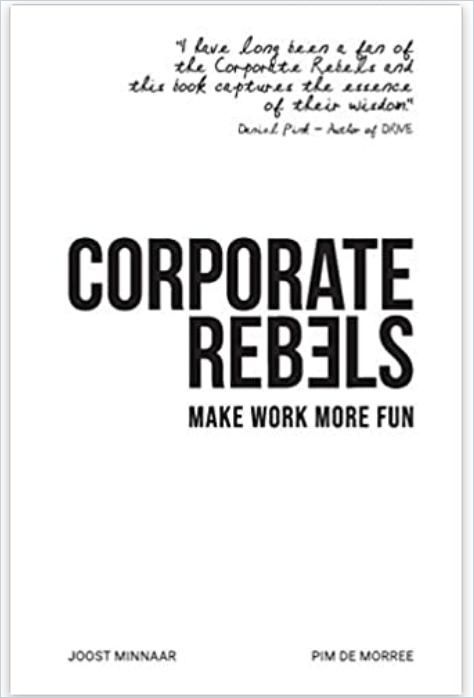Joost Minnaar and Pim de Morree left corporate life to research radical, pioneering companies and explore their methods; their discoveries provide a practical blueprint for effective 21st-century organizations.

Workplace Trailblazers
Dutch corporate escapees Joost Minnaar and Pim de Morree quit their uninspiring engineering jobs in 2015 and traveled the world to find workplace pioneers who run radical, rebellious organizations. The authors share tales of their travels and introduce you to workplace trailblazers they met along the way.Compelling themes of corporate transformation, flat organizations and transparent cultures emerge in these illuminating encounters.
Patagonia
In 1973, Yvon Chouinard founded Patagonia, which makes equipment and clothing for mountaineers, skiers, snowboarders, surfers, fly-fishers and runners. Employees spend time outdoors and use the products they make.
In 1994, Patagonia switched from cotton and other conventional materials to organic cotton to fight pollution. It spent $20 million to set up its organic operation. Two years later, it switched to organic products overall.
Patagonia’s people enjoy autonomy and face minimal rules. When they need new office space, they search for an old building they can save from demolition and seek furniture and fixtures to recycle and refurbish.
Haier
When Zhang Ruimin, CEO of Haier, a Chinese company that sells appliances (”whitegoods”) and electronics, learned that 20% of his corporation’s manufactured refrigerators were defective, he gathered 76 broken fridges, put them on the factory floor and smashed them to pieces.
Ruimin created 2,000 self-organizing units, Zi Zhu Jing Ying Ti’s (ZZJYTs), and gave them freedom to innovate. Employees, vendors and customers voted on which ideas had the most potential. Then Haier formed ZZJYT committees to pursue the strongest ideas, each one under the leadership of the person who originated the concept it was assigned to develop.
We create an organization that puts entrepreneurship at its heart. Everyone can be their own CEO.Haier CEO Zhang Ruimin
Haier eliminated 12,000 middle-management positions to create 2,000 ZZJYTs, which generated 4,000 microcompanies led by as many as 200 entrepreneurs. Each unit is responsible for creating its own HR and management and for creating its own products and delivering them to customers.
Employee Self-Management
Ari Weinzweig is CEO of Zingerman’s Community of Businesses, which has 700 employees, generates $70 million per year, and includes restaurants, a mail-order company, a coffee roasting house and a training office.
At new employee orientations, Weinzweig gathers new hires around a table at his restaurant. He breaks off a piece of bread, discusses how it’s made and why the restaurant serves it. He invites the new hires to feel, smell and taste the bread. Then he takes up to two hours to answer their questions.
We regularly experienced the HIPPO-effect (Highest-Paid Person’s Opinion). This refers to the habit of siding with the highest-ranking officer (and therefore often the one drawing the top salary) and not acknowledging the person who has the most expertise, experience or the brightest ideas.Joost Minnaar and Pim de Morree
To end bad leadership, don’t listen only to the highest-paid people; employees express themselves more freely to junior managers. Get rid of corner offices and reserved parking spaces. Manage from the bottom up, not the top down. Let employees be experts in their areas instead of promoting them to management. Workers should choose their leaders.
Freedom and Trust
The New Zealand-based asset management firm Perpetual Guardian offers a four-day workweek while paying employees for five days.
One of the most common mistakes is to bring in the wrong managers, the kind who take full control. This feels safe, but it’s lacking in trust – and employees are deprived of responsibility and ownership. Frank van Massenhove
Pioneering practices that are drawing widespread attention include judging productivity on results rather than hours and offering peer review instead of top-down leadership. Some radical firms allow employees to set their own salaries.
Decentralize Authority
David Marquet, a US Navy submarine commander, wrote Turn the Ship Around!: A True Story of Turning Followers into Leaders.Marquet was supposed to command a highly regarded ship, the USS Olympia. Instead, the navy ordered him to take charge of the USS Sante Fe because its captain quit. The ship was in trouble, and it sat at the bottom of submarine rankings.
The Sante Fe…was the ugly duckling of the US Navy, used as a case study on how not to do things…the sub we all laughed at…She was the worst-performing, with the lowest morale and retention rate of any submarine. The year before I took command, of the 135 crew members, precisely three had re-enlisted. David Marquet
The crew proved dysfunctional. Only five officers understood what the sub needed. For example, a pump in the middle of a deck didn’t work because the supply department chief didn’t receive orders from the machinery department chief to requisition a new part. On a traditional submarine, a captain issues orders and the crew follows them. Marquet instead provided general guidelines and let his officers create task lists. Three weeks later, the USS Sante Fe passed inspection and began its climb from the bottom of submarine rankings to the top.
Progressive companies vest in decentralized structures, as did Marquet. They outline their decisions to identify who will make choices, change passive language to active, and push out command-and-control hierarchy.
Semco
Ricardo Semler, CEO of the Brazilian company Semco, took over from his father. The elder Semler ran a traditional, bureaucratic company. When he went away for a business trip, he gave his son complete authority. Ricardo Semler fired half the top 15 managers and implemented new procedures. Staff morale fell, but improved with the arrival of a new HR director, Clovis Bojikian.
Semler and Bojikian shared the desire to build a more open and transparent corporate culture. They eliminated set work hours and perks, such as personal parking spaces. They allowed every employee to examine monthly balance sheets, profit and loss accounts, and their units’ statements on cash flow.
Keep people in the dark, and they tend to assume the worst. Joost Minnaar and Pim de Morree
They flipped the performance evaluation process; employees reviewed their managers, scoring them from zero to 100. Employees responded positively, and Semco let them select their own managers. HR made individual teams responsible for hiring their own new members.
“Radical transparency” builds trust and generates involvement through communication, openness as the company’s default approach, open-book management, and transparency regarding performance objectives, goals and salaries.
How It’s Done
In this terrific, eye-opening, well-written manual for positive, necessary change, Joost Minnaar and Pim de Morree, enthusiastic correspondents, write passionately in a direct, conversational voice that underscores their message about overturning obsolete hierarchies. They wisely vest in compelling personalities and show how companies reflect their leaders’ personal values – thus the authors avoid boring process and protocol descriptions as they teach readers that leaders flourish when they know themselves.
Other books on alternative approaches to life and businesses include Rebels at Work: A Handbook for Leading Change from Within by Lois Kelly and Carmen Medina, and Rebel Talent: Why It Pays to Break the Rules at Work and in Life by Francesca Gino.





